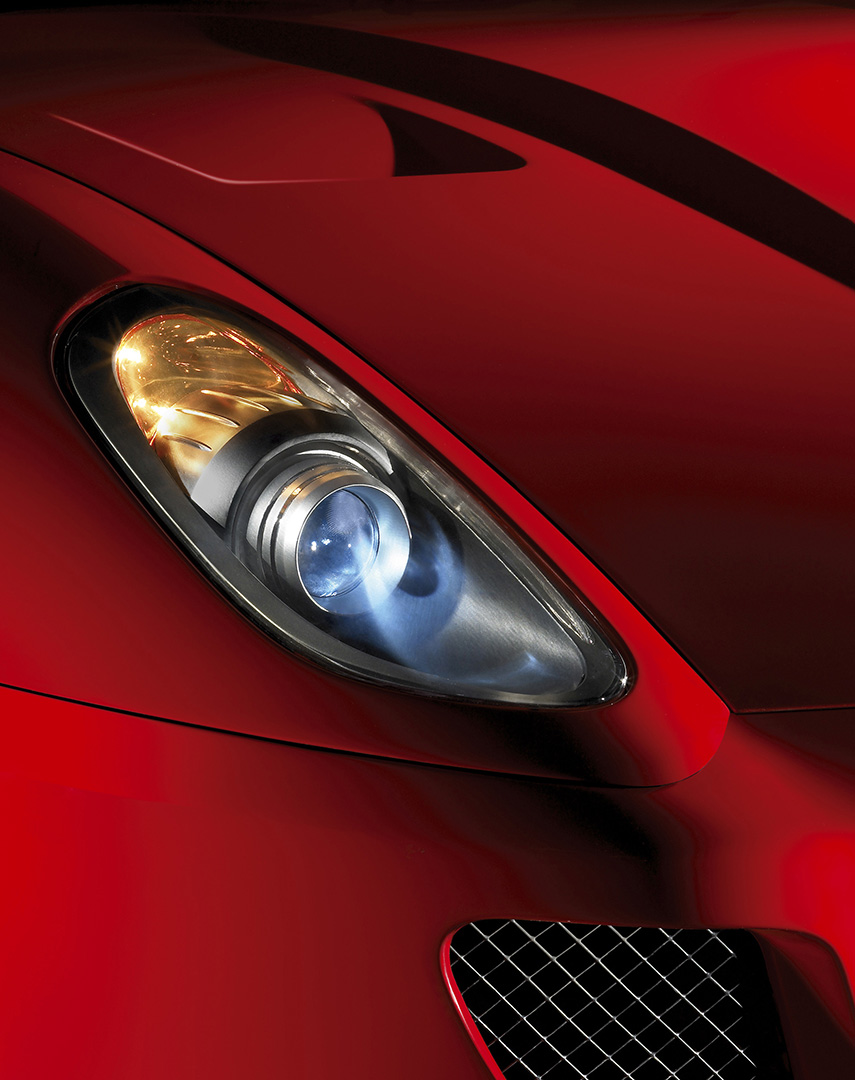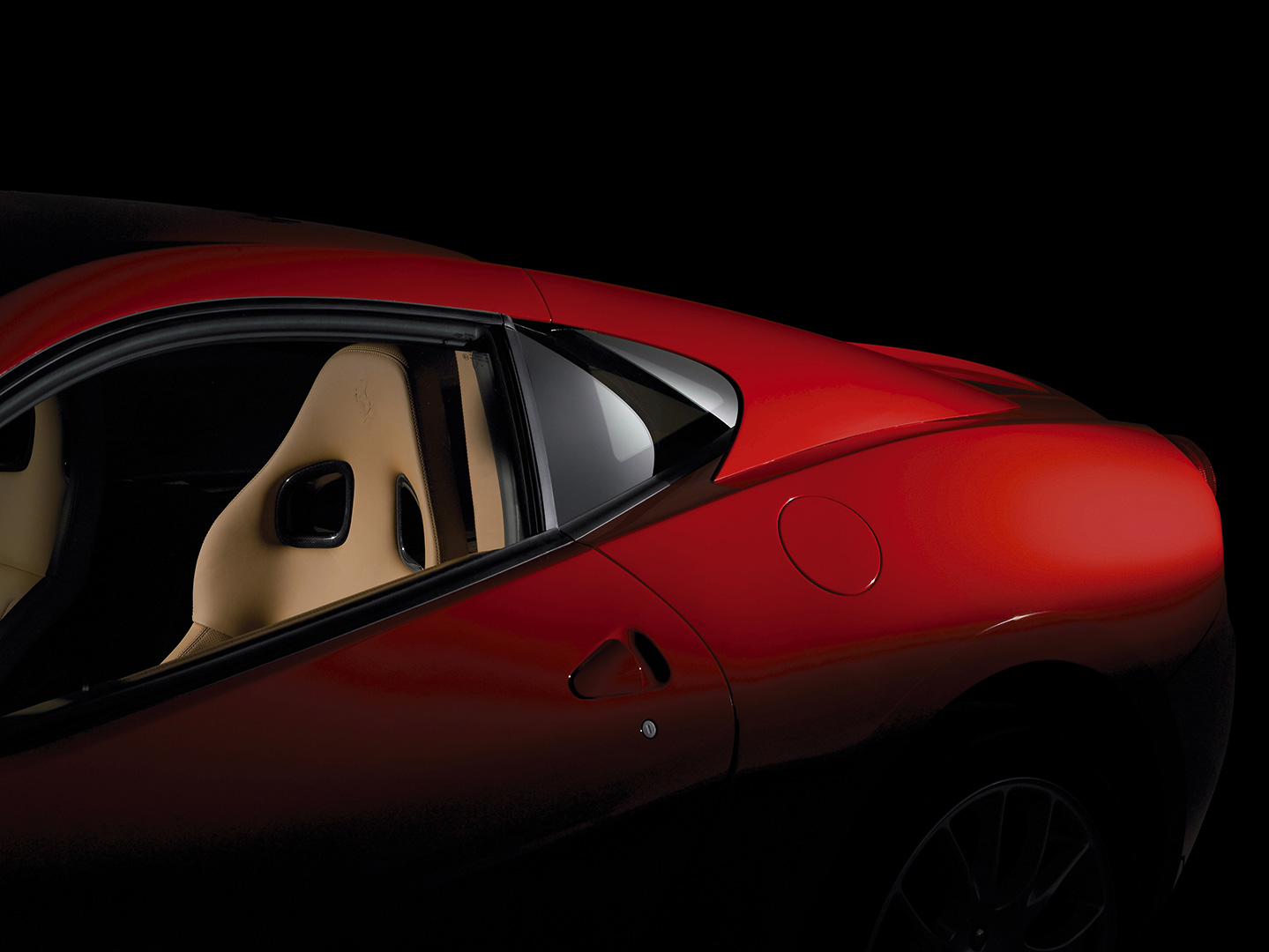?width=1920&height=1600)
Ferrari 599 GTB Fiorano
The Ferrari 599 GTB Fiorano was designed with several specific objectives in mind: to increase driving pleasure, to guarantee performance (courtesy of technology transfers from the F1 single-seaters), and to ensure comfort, ergonomics and safety. The Ferrari 599 GTB Fiorano sprints from 0 to 100 km/h in 3.7 seconds and has a top speed in excess of 330 km/h. The car takes its name from the Fiorano circuit Ferrari uses to hone the performance of its track and road cars. ‘GTB’ stands for Gran Turismo Berlinetta, after the most famous Ferrari berlinettas ever built, and ’599′ is the displacement of the V12 engine divided by 10.

Wholly innovative lines
With the Ferrari 599 GTB Fiorano, Pininfarina designers wanted to explore wholly innovative lines. As ever, this was not an isolated process, but took place alongside optimisation of the car’s exterior aerodynamics, which were designed to deliver cutting-edge down-force figures. The cabin too was given an original aerodynamic design. The wraparound rear window is hugged by two flying buttresses, which channel air towards the nolder, adding a highly original (yet functional) twist. When it came to the rear of the car, it seemed time to depart from the now signature circular quad rear lights and low-fixed licence plate.

Its front is dominated by the volumes of the mud guards which extend as far as the bumpers so that it seems that in seems that the central section, bonnet and air intakes are set into them. The surfaces are wonderfully sculptural and muscular too. The striking front air intake is flanked by two purposeful air outlets. The bonnet is characterised by a bulge that provides a styling cue T as to the potent V12 housed below, beside it two diffusers for warm air lighten the lines too. The air vent on the front wheelarch continues through to the door panel, delineating the rising swage line and the muscular surface treatment. The rear wheelarch volumes protrude slightly from the sides like muscles rippling under an athlete’s skin. The air intakes for the fuel tank and gearbox cooling systems create a certain symmetry with the front air diffuser.

The design of the wheel rims, with weight-saving double spokes, are a nod to the famous Ferrari berlinettas of the past too. The cabin too was given an innovative aerodynamic design. The wraparound rear window is hugged by two flying buttresses which channel the air towards the nolder, adding a highly original yet functional twist. When it came to the rear of the car,it seemed time to depart from the now signature circular quad rear lights and low-down licence plate. The Ferrari 599 GTB Fiorano has large singular LED rear lights set into the tail and although the licence plate is still on the bumper, it has been shifted to the upper part of it. The diffuser on the rear bumper was subject to lengthy aerodynamic development, and integrates with the fairing around the exhaust tailpipes. However, the Ferrari 599 GTB Fiorano is a strikingly sculptural car, its surfaces beautifully honed and modelled by Ferrari’s designers and engineers. The design is so supple, in fact, that every angle brings something new to light. All of the freedom allowed in designing an extreme sports car was used here and the result is endlessly surprising.

The Ferrari 599 GTB Fiorano is a strikingly sculptural car, its surfaces beautifully honed and modelled by Ferrari’s designers and engineers. The design is so supple, in fact, that every angle brings something new to light. All of the freedom allowed in designing an extreme sports car was used here and the result is endlessly surprising. A balance has been struck in the interior between the car’s sporty vocation and the intimacy that only skilled hand-crafting and detailed personalisation can achieve. The passenger areas of the car are trimmed in sumptuous leather while the driver area and controls boasts more high-tech detailing in carbonfibre and aluminium. In addition to the steering wheel and manettino, the central rev counter with a choice of red or yellow background and solid aluminium passenger controls, the new 599 GTB Fiorano also boasts attractive new styling cues including a central grip to provide extra purchase for the passenger and new adaptive racing seats featuring carbonfibre side rests.

The Ferrari 599 GTB Fiorano also benefits from an alredy vast choice of personalisation options available for every Ferrari model. Four areas are covered by this programme: Racing and Track, Exteriors and Colours,Interior and Materials, Equipment and Travel. The Racing options include CCM (Carbon Ceramic Material) brakes, four-point harnesses and a cockpit roll-bar while the Interior and Materials options include a new Enzo Ferrari-inspired carbon-fibre steering wheel with LED rev display which can be specified along with a special carbon-fibre trim kit for the door panels, instrument panel, gear stick surround and sill kick panels. Scuderia Ferrari shields, Daytona-style seats with perforated inserts, a satellite navigation system with display on instrument panel and much, much more besides are also available as part of the personalisation programme.

CHINA LIMITED EDITION
Lu Hao, the first Chinese artist to work with Ferrari, created this special model decorated with Song Dynasty Ge Kiln pottery patterns. The innovative appearance of this unique model blends classic Chinese elements with Ferrari distinctive features.

Derived from the ultra-competitive world of Formula 1
One of the unique strengths of the current Ferrari range is the F1-type gearbox. This was taken a step further in the design of the Ferrari 599 GTB Fiorano resulting in the astonishing F1-SuperFast. The new gearbox’s name encompasses the two key concepts behind its design: the fact that it is derived from the ultra-competitive world of Formula 1 and the faster-than-ever gear shifting times it delivers. In fact, it is one of the Ferrari 599 GTB Fiorano’s most innovative and exclusive features and is yet another world first on a roadgoing car.

In yet another first for a road car, the Ferrari 599 GTB Fiorano comes equipped with the F1-Trac traction control system which previously only Ferrari’s F1 drivers enjoyed. However, Ferrari’s track experience is now such that this system has been adapted for industrial production. Because it is so much faster and more precise than a traditional system, the F1-Trac will give even less expert drivers the confidence to really make the most of their car’s potential and stability.

The damping action exerted by a car’s suspension plays a key role in guaranteeing fun driving and easy handling across the board. The Ferrari 599 GTB Fiorano’s SCM Magnetorheological Suspension system, however, is exceptionally efficient even by the Prancing Horse’s renowned standards.


optimisation of the car’s exterior aerodynamics
The Pininfarina designers had one clear but ambitious goal in designing the Ferrari 599 GTB Fiorano. They wanted to clothe it in innovative lines that would still have all of the trademarks of Ferrari’s sportiest and most high performance models. As ever, this process was not a standalone one but took place hand in hand with the optimisation of the car’s exterior aerodynamics which were designed to deliver cutting-edge downforce figures. The car’s design was developed around front-sloping lines which give it a thoroughly dynamic stance from the side

Its front is dominated by the volumes of the mud guards which extend as far as the bumpers so that it seems that the central section, bonnet and air intakes are set into them. The surfaces are wonderfully sculptural and muscular too. The striking front air intake is flanked by two purposeful air outlets. The bonnet is characterised by a bulge that provides a styling cue T as to the potent V12 housed below, beside it two diffusers for warm air lighten the lines too. The air vent on the front wheelarch continues through to the door panel, delineating the rising swage line and the muscular surface treatment. The rear wheelarch volumes protrude slightly from the sides like muscles rippling under an athlete’s skin. The air intakes for the fuel tank and gearbox cooling systems create a certain symmetry with the front air diffuser. All of the freedom allowed in designing an extreme sports car was used here and the result is endlessly surprising. During the styling process, various test sessions were held to verify the aerodynamic efficiency of the forms developed.

Unsurprisingly, the Ferrari 599 GTB Fiorano was found to be the most aerodynamically efficient 12-cylinder front-engined sports car ever built by the Prancing Horse company. Lengthy testing in the wind tunnel and other simulations at Ferrari has yielded stunning results in terms of both downforce and drag. Thanks to the optimisation of the car ‘s flat underbody and the rear diffuser, the aerodynamic rear blends in beautifully with the rest of the design and the suction created under the car is now far superior to the lift generated by the upper part of the bodywork. A small nolder on the top of the rear windscreen also separates the air flow and contributes to reducing lift over the car ‘s upper surface and thus increasing downforce. The result is an aerodynamic load (Cz= 0.190) of 70 kg at 200 km/h, 160 kg at 300 km/h and 190 kg at top speed. This is distributed between the front and rear axles in the same way as the car weight is. Lengthy research into internal air flows and into keeping the car’s wake as smal as possible have resulted in a drag coefficient (Cd) of just 0.336.


Directly from the Enzo’s
The Ferrari 599 GTB Fiorano’s engine is a 65° V12 with a 5999 cm3 displacement that delivers a specific power output of 103 hp/litre. Its architecture was derived directly from the Enzo’s. A further development of the same engine, this time for track-only use, was used on the recent Ferrari FXX also. The basic architecture of the Enzo engine was retained (block, cylinder heads, sump and combustion chamber geometries) while new components and subassemblies were designed to yield high engine revs, significantly reduce weight and optimise its distribution,and yield a more compact power unit.

The result is that the new engine is mounted in the mid-front position and delivers enhanced performance and reduced fuel consumption whilst complying with the very latest emission standards. The engine, known in-house as the F140C, has a completely different structure from the one that powered the previous generation of Ferrari 12-cylinder berlinettas, the 550 and 575M Maranello. It delivers absolutely stunning driving pleasure thanks to incredibly smooth power delivery and the wonderful signature engine sound.

The maximum engine speed – 8400 rpm (+900 rpm on the 575M Maranello, an increase of 12%) – is one of the highest achieved by a car of this displacement and in fact is comparable only to that of the Enzo. In other words, it sets a whole new benchmark in terms of sportiness and driving pleasure. The engine’s specific power output of 103 hp/litre (13 hp/litre more than that of the 575M, +14%), is the highest achieved by a naturally aspirated engine of this displacement and provides further proof of the fluid dynamic efficiency of the unit. The latter is guaranteed under all conditions by chain-driven distribution and twin overhead camshafts per cylinder bank with hydraulic tappets and continuously variable timing on both inlet and exhaust cams to optimise torque delivery. The inlet tracts were also optimised too. Exceptionally smooth power delivery right across the range up to 620 hp at 7600 rpm (+105 hp or +20% on the 575M) guarantees easy handling and vehicle control at all times.

- V12ENGINE
- 366.08 cu inTOTAL DISPLACEMENT
- 620 CVMAXIMUM POWER @ 7600 rpm
- >205 mphTOP SPEED
- Overall length183.7in
- Overall width77.2in
- Height52.6in
- Wheelbase108.3in
- Front track66.5in
- Rear track63.7in
- Dry weight3482 lb*
- Kerb weight3722 lb*
- Boot (trunk) capacity11.3 cu ft
- Fuel tank capacity27.7 US gal (23.1 UK gal)
- Weight distribution47%/53% front/rear
- Front13.9 x 1.3in
- Rear12.9 x 1.1in
- Type65° V12
- Bore/stroke3.62 x 2.96in
- Unit displacement30.51 cuin
- Total displacement366.08 cuin
- Compression ratio11.2:1
- Maximum power456 kW (620 CV) at 7600 rpm
- Maximum torque608 Nm (448 lbft) at 5600 rpm
- Maximum revs per minute8400 rpm (with limiter)
- Specific output103 CV/I
- Transmission and gearboxManual or F1; 6-gears+Reverse
- Electronic controlsTyres pressure and Temperature
- Electronic controlsMonitoring System TPTMS
- Electronic controlsControl for Stability and Traction with F1-Trac
- Front245/40 19”
- Rear305/35 20”
- SuspensionMagnetoreological
- Suspensiondamping control SCM
- Maximum speedover 205 mph
- 0-100 km/h (0-62 mph)3.7s
- 0-200 km/h (0-124 mph)11s
- Combined17.9 l/100km
- Combined401g/km
- *European market version manual gearbox
- Design
- Vehicle dynamics
- aerodynamics
- Engine
- Technical Details
- Media gallery